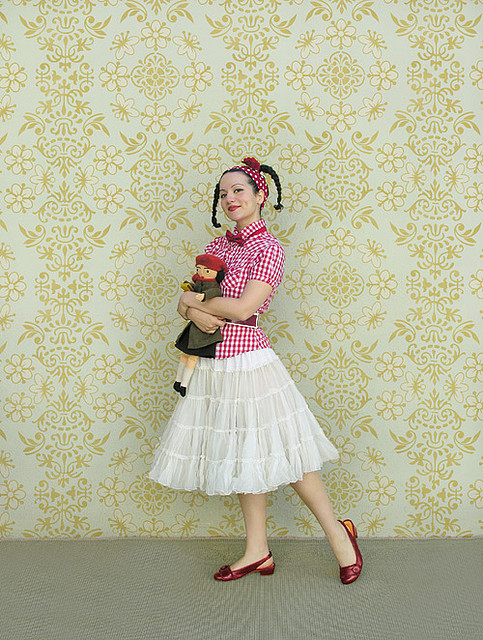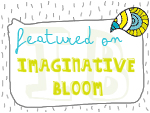 Photo by Elsita (Elsa Mora) on Flickr
Photo by Elsita (Elsa Mora) on Flickr
From my last guest post on Imaginative Bloom – Why You Need an Ideal Customer Profile – I hope you realized how important it is to identify your ideal customer. Now, I’m going to tell you how to do it.
Remember that Your Ideal Customer Lights You Up
You can start to narrow down your ideal customer by knowing who isn’t your ideal customer. Start by making a list of the “not so fun” customers you’ve had in the past. This could be someone you liked but didn’t connect with. This could be someone who seemed interested in your services at first, but always had an excuse as to why she didn’t follow through. What characteristics do these customers share?
What customer experiences have lit you up? I want you to stick with the experiences that have made you jump out of bed in the morning to start working, enticed you to work well past your bedtime, and made you smile. What characteristics do those customers have in common? Make a list.
Physical Characteristics
Now, I want you to close your eyes and imagine your ideal customer. I want you to picture what she looks like. Take out a sheet of paper and start describing the physical characteristics of your ideal client. If you’re having trouble with this, flip through a magazine until you find your “ideal client.” Make sure you include age and gender in your physical description.
Some people get stuck writing out a physical description, because they have clients that look completely different. That’s okay. Many of them might be your ideal customers, but for the purpose of this exercise, pick one.
Employment Characteristics
In the next paragraph, describe your ideal customer’s employment status. Ask yourself these questions:
- Where does she work?
- What’s her specific job title?
- How much money does she make?
- What’s her level of education?
This information can help you determine price points on your products and services, and it can help you better understand what characteristics you should target in your marketing.
Emotional Characteristics
Continue picturing this ideal customer in your mind, and try to get in her head. Ask yourself these questions and fill in the next paragraph of your description using them:
- What does she love to do?
- What is she most afraid of?
- What is her biggest problem at home?
- What is her biggest problem at work?
- Is she married or single? Is she happy with her relationship status?
- What movies does she watch? What books does she read?
- What does she value?
- What are her goals?
Complete this Exercise More Than Once
All of your ideal customers don’t fit into a neat little box, so write a few ideal customer profiles varying the characteristics—but always stick to characteristics you would find in an ideal customer. Write one profile each day for the next three days. This will help to open your eyes to the specific market that you’re trying to reach.
Use Your Ideal Customer Profiles
Once you’ve done this exercise, put it to good use. There are many ways that you can use these profiles to target your ideal market.
First, you can read your descriptions and brainstorm places that your clients hang out. If your ideal customer is a single mother, you might find her on support blogs for single moms or in specific forums for single moms. Go where your clients are and interact with them. Answer their questions on forums and on Twitter, leave comments on their blogs, and chat with them on Facebook.
Second, you should always look over one of your ideal customer profiles before you write anything—a blog post, product description, sales page, or other marketing materials—and write them directly to that person. Narrow your focus and seriously pretend that you’re writing to your ideal customer. I promise this will help you attract the right customers for your business.
Third, you can use your profiles to make products that will help your ideal clients solve their biggest problems. When you can imagine your customers’ fears, values, goals, and dreams, you can make products and deliver services that they want and need.
I believe taking the time to think about and write your ideal customer profiles will increase your business success, make marketing much easier, and allow you to attract the customers that you really want—and who really want what you have to offer.
________________________________________________________
 About April
About April
April Bowles-Olin works with creative women to lead more fulfilling lives while they make money doing it. She also attempts to add a little prettiness to the world with her art and jewelry. You can learn more about her at Blacksburg Belle or connect with her on twitter @blacksburgbelle.
 Foto by Elsita (Elsa Mora) in Flickr
Foto by Elsita (Elsa Mora) in Flickr
Dal mio ultimo guest post in Imaginative Bloom – Perché hai bisogno di un Cliente Ideale – spero che abbiate capito quanto sia importante identificare il vostro cliente ideale. Ora, sto per dirvi come farlo.
Ricorda che il tuo Cliente Ideale ti “illumina”
Puoi restringere la tua ricerca del cliente ideale sapendo chi non è il tuo cliente ideale. Inizia facendo una lista dei clienti “meno simpatici” con cui hai avuto a che fare in passato. Può essere qualcuno che ti piaceva ma che con cui non ti sei connesso. Può essere qualcuno che sembrava interessato al tuo servizio inizialmente, ma che aveva sempre una scusa per il fatto di non seguirti. Che caratteristiche hanno questi clienti?
Quali sono le esperienze con i tuoi clienti che ti hanno “illuminato”? Voglio che tu tenga ben presente quelle che ti fanno saltare giù dal letto al mattino con la voglia di iniziare a lavorare e di farlo anche oltre l’orario di lavoro, quelle che ti regalano un sorriso. Che caratteristiche hanno in comune questi clienti? Fai una lista.
Caratteristiche Fisiche
Ora, voglio che tu chiuda gli occhi e che immagini il tuo cliente ideale. Voglio che ti immagini come è fatto. Prendi un foglio di carta e inizia a descrivere le caratteristiche fisiche del tuo cliente ideale. Se hai delle difficoltà a fare questo, sfoglia una rivista finchè trovi il tuo “cliente ideale”. Assicurati di aggiungere anche età e sesso nella tua descrizione fisica.
Alcune persone si bloccano davanti al dover buttar giù una descrizione fisica, perchè hanno dei clienti che sembrano totalmente diversi. E’ ok. Molti di loro possono essere i tuoi clienti ideali ma, per il fine di questo esercizio, scegline solo uno.
Caratteristiche Impiego
Nel prossimo paragrafo, descrivi lo stato di occupazione del tuo cliente ideale. Fatti queste domande:
- Dove lavora?
- Qual’è nello specifico il suo titolo di lavoro?
- Quanti soldi guadagna?
- Qual’è il suo livello di educazione?
Questi punti possono aiutarti a determinare i prezzi dei tuoi prodotti e servizi, e possono aiutarti a capire meglio quali caratteristiche dovresti targhettizzare nel tuo marketing.
Caratteristiche Emotive
Continua a visualizzare ed immaginare nella tua mente il tuo cliente ideale e cerca di entrare nella sua testa. Fatti queste domande e usale per compilare il prossimo paragrafo:
- Cosa gli piace fare?
- Cosa gli fa più paura?
- Qual’è il suo più grande problema a casa?
- Qual’è il suo più grande problema al lavoro?
- E’ sposato/a o single? E’ felice dello stato della sua relazione?
- Che film guarda? Che libri legge?
- Cos’ha valore per lui/lei?
- Quali sono i suoi obiettivi?
Fai questo esercizio più di una volta
Tutti i tuoi clienti ideali non potranno stare nella stessa piccola scatola, perciò scrivi qualche altro profilo di cliente ideale variandone un pò le caratteristiche — ma tieni sempre in mente le caratteristiche che tu vorresti trovare nel tuo cliente ideale. Scrivi un profilo al giorno per i prossimi 3 giorni. Questo aiuterà ad aprire gli occhi sul mercato specifico che stai provando a raggiungere.
Usa il profilo del tuo Cliente Ideale
Una volta che hai fatto questo esercizio, fanne buon uso. Ci sono molti modi in cui puoi usare questi profili per targhettizzare il tuo mercato ideale.
Primo, puoi leggere le tue descrizioni e fare un brainstorm circa i posti nei quali i tuoi clienti vanno/stanno. Se il tuo cliente ideale è una mamma single, potresti trovarla in un blog di supporto per mamme single o in forums specifici per mamme single. Vai dove sono i tuoi clienti e interagisci con loro. Rispondi alle loro domande nei forums e su Twitter, lascia commenti nei loro blogs e chatta con loro su facebook.
Secondo, dovresti sempre guardare al profilo del tuo cliente ideale prima di scrivere qualsiasi cosa – un post per il blog, la descrizione di un prodotto, la pagina per le vendite, o altri amteriali di marketing – e scriverli direttamente a quella persona. Restringi il campo e immagina seriamente che stai scrivendo al tuo cliente ideale. Ti prometto che questo ti aiuterà ad attrarre i giusti clienti per il tuo business.
Terzo, puoi usare i tuoi profili per fare dei prodotti che aiuteranno i tuoi clienti ideali a risolvere i loro più grandi problemi. Quando puoi immaginare le paure dei tuoi clienti, i valori, gli obiettivi e i sogni, puoi fare prodotti e fornire servizi che voglio e di cui hanno bisogno.
Credo che prendersi del tempo per pensarci e scrivere i profili dei tuoi clienti ideali aumenterà il tuo successo, renderà il tuo marketing più facile, e ti permetterà di attirare i clienti che veramente vuoi – e che veramente vogliono ciò che tu hai da offrire.
________________________________________________________

Chi è April
April Bowles-Olin lavora con donne creative per far condurre loro una vita più appagante, guadagnando mentre fanno ciò che amano.
Cerca anche di dare un pò più di bellezza e grazia al mondo con la sua arte e i suoi gioielli.
Potete conoscere meglio April nel suo blog Blacksburg Belle o entrare in contatto con lei su Twitter @blacksburgbelle.





Oh my goodness! Amazing article dude! Many thanks, Hoowever I am experiencing troubles with your RSS.
I don’t understand why I can’t join it. Is there anyone else getting
similar RSS issues? Anyone who knows the answer will you kindly respond?
Thanx!!
Another option to have a secure home is to change
your lock rather than install a new. The very running property that is car or other vehicle is
also locked to avoid its theft. A locksmith Apache service provider will be able to help you install a wide
variety of locks and security devices that can improve the security of your
house.
I couldn’t resist commenting. Very wewll written!
John Wild is vice president of Absolute Access & Security. • Don’t forget to check its compatibility with your building structure and the ability of the system to
deliver a good sound quality which depends on the structure of your home.
Make sure you clean your face thoroughly before moisturizing.
Finally! I’ve been so frustrated with the general term “target market” and the lack of creative and concrete examples to extract his or her desires/needs/values. You have given a great exercise to clarify how I may approach this very important factor. Thank you for your refreshing perspective!
Dear April,
Thank you for this really useful article. It has turned around the way I see my customers and the way I will address them from now on. The article and the clarifications in the comments.
It is still truly up-to-date and to the point. I know it would help many emerging and even established artisans and handmade artists in my country. May I have your permission to translate it to Romanian for all the non-English speaking artists in my community? This and the article about the reasons for which to identify your ideal customer.
If someone else has done this already, please let me know.
Thank you and I’m looking forward to your response.
Cheers!
Andi
I’m desperate for marketing tips – I feel like a tiny fishlette in the Atlantic! So I’m going to give your method a try. I don’t sell offline so should – in theory – be able to imagine my ideal customer better. Cheers Lisa
https://www.etsy.com/uk/shop/LisaDeluxe
Hi April
very usefull piece of information thanks so much it helps me alot
muge
Thanks for showing us the way!:)
Hi,
I appreciate your replies and just want to clarify my position on this topic. I completely agree with both the following points that you made in your former article: “Why you need an ideal customer profile.”
“Here’s the deal. You want to find the customers who relate to you, who want your products, understand the value of your products, and will pay the prices that you really should be charging.”
“Many crafters and artists aren’t charging enough for their products and services. When you do this, you become burnt out and resentful. You also get customers who want a bargain and don’t really understand the value of your products.”
Although I am not remotely a marketing expert, I appreciate the value of niche marketing. Where you lose me, is what I perceive as basically judging books by their covers. I feel that it would be more useful to simply imagine customers who truly value our art/product/service, etc. regardless of what package that customer comes in.
Take your example: “if you sell aprons, your ideal customers might range in age from 22-55″.
I would suggest that even that age range is too narrow. What about a 16 year old girl who has discovered a passion cooking? Or a spry 90 year old grandmother who still loves to bake? Or even, a middle-aged man who likes to cross dress in the privacy of his own home and thinks the aprons are pretty?! I’m not being flippant – I’m just suggesting that any of these people might turn out to be a “customer who makes you happy” and truly values your work.
Hey Elizabeth,
Thanks for clarifying! And, I get where your concern comes in.
The purpose of getting so specific {including looks} is to talk directly to one person in your product descriptions, blog posts, and email newsletters. That’s also why it’s a good idea to have more than one ideal customer.
You’re not going to say anything about how this is the perfect product for someone with blonde hair and blue eyes–but if you can pictures that person in your mind, you usually have an easier time writing your marketing materials that produce an emotional response for your customer. And, that leads to sales.
When people put this exercise into practice, the response they get from customers is usually something like this: “It felt like you were talking directly to me.” Or, “I had to buy this product, because it felt like the perfect fit.”
Sometimes, when I send out an email newsletter, I’ll get multiple responses from people who say, “You knew exactly what I needed to hear.” Or, “It felt like you were talking to me even though I know you send this out to your entire list.” Obviously, I wasn’t picturing all of those diverse people in my mind when I was writing the email newsletter…but they all connected to it, because I got specific and talked to one person in my marketing. This is why I have loyal customers, readers, and fans. When I send out an email newsletter that includes a product, I know that within 30 minutes, I’ll have at least a handful of sales. That’s how I do it–I get specific.
And, I hardly ever mention anything about age, physical characteristics, or income unless I think it’s really obvious. For instance, one consulting client was making these big, colorful earrings and she was marketing them like they were perfect for teens and grandmothers. Well, they weren’t and people weren’t buying them online. In person, teens and young women bought them at craft shows. However, online–she wasn’t having any luck. Her biggest issue was that she wasn’t marketing to young women. She didn’t want to miss out on older women buying her earrings–but they weren’t buying them anyway. And, teens aren’t going to buy something that says, “perfect for grandmothers” on it. So, I helped her focus her marketing material, and now, she makes money selling her products online. When she was selling to everybody, she was selling to no one.
And, with the apron example, you’re right. A middle-aged man who likes to cross dress might buy the product–but how often is that going to happen? My guess is less than 10% of the sales would come from these outside groups that you mentioned which means it wouldn’t make sense to market to those people directly. It would be a waste of time and money. And, when you’re running a small business, you don’t have a lot of either to waste.
Sorry, I don’t want to be negative but I really don’t like this kind of profiling. It creates stereotypes and narrow, faulty demographics. Someone’s age or level of education, in my experience, doesn’t necessarily tell you anything about their tastes or values. This just seems like another way to pigeonhole people and by doing so, you may just miss your perfect customer!
Hey Elizabeth,
I completely appreciate your comment and response. However, I have to disagree. I help people narrow their target market all the time through individual consulting and their sales dramatically increase. When you write an ideal customer profile, you’re imagining the perfect customer for your product. Plus, you should write more than one. So, one ideal customer might be a twenty year old who’s in college without lots of money. Another ideal customer might be a woman in her 30s. And, that’s completely fine! You can have multiple ideal customer profiles.
Sometimes, you can’t narrow by something like level of education or age for all your ideal customers. But, for the purpose of the exercise, you want to get as specific as you can. That doesn’t mean you say, “Hey, my ideal customer is 25. You can’t buy my product.” Instead, you use the information to better your marketing, and if other people buy, that’s awesome.
For instance, if you sell aprons, your ideal customers might range in age from 22-55. So, you wouldn’t focus on age in your marketing. Instead, you’d focus on other traits such as a woman who enjoys spending time in the kitchen and wants something special to wear during that time. But, when you write the ideal customer profile, you might pick the age 33 just to get specific. So, you can imagine the ideal customer in your mind. In my experience, this can increase your ability to talk directly to the type of person who is most likely to buy your product.
But, I can see where you’re coming from completely. When I first learned about this concept, I had similar thoughts. Then, I realized that it was a tool to help me market my creative products better–not a tool to stereotype. If you want to read more about it, check out the book: Duct Tape Marketing.
Like most marketing experts, I say, “If you sell to everyone, you sell to no one.” You don’t build a tribe or a loyal following by selling to the masses {unless you compete on price like Walmart}. Some great examples of companies who know their target market well and market directly to those people are Anthropologie, Vera Bradley, Kate Spade, and Apple. And examples of people include Marie Forleo, Naomi Dunford, and Michelle Ward.
I hope that helps clarify the article :) And, I’d love to hear your thoughts.
Hi Elizabeth, thank you for sharing your thoughts with us. It’s always a good way to grow and learn together.
I must say that I agree with what April says in the comment above, and hope that her clarification has helped to have a better idea of the process and meaning of Creating an Ideal Customer Profile.
I think I couldn’t be able to explain it better than so.
I also think that the book suggested by April and a look to the work of the people she mentioned, can give you a further idea and clarification about the topic.
Please feel free to let us know what you think :)
Really appreciated your article, it gave me much to think about as I embark on my new Etsy shop.
Happy it can be helpful for your new Etsy shop adventure Lisa!
Thank you for stopping by :)
I find this approach very different and fun! I’ll write at least three ideal customers’ profiles and I’m sure it will help. Writing descriptions like talking to them: brilliant! Thank you!
Hi Irene, thanks a lot for your feedback.
It sounds full of energy and inspiration! Happy you found this article useful.
Let us know your results! :)
Thank you all for stopping by and for your comments. April and I are really happy to hear that this post has been helpful for so many people!
Thank you so much guys!
Thank you so much for your advice! That exercise is soooo helpful!! I’ve been trying to do something like this in my mind, finding the right market and trying to explain it to a few people, however, I couldnt get it right!
Now, I WILL have the right answer to WHO is my Ideal Customer ;)
I never thought about this before! I guess that’s because I always thought my ideal customer was someone exactly like me! I still think I may be on to something, but your post gives me some ideas about what to do about it. Thanks!
love your insights, tweeting this to my tweeps
April! Once again, you are immensely helpful :) I’ve just written my profiles in my artist’s journal and I’ll be reading them the next time I write anything!!
@Ruby and @Kelly: Thank you for leaving your feedback girls, they’re really appreciated :)
Wow! Thank you so much for this amazing input!
Since beginning my online adventure this is just what I have been looking for. Thank you for posting this!
This is so good and interesting. I’m going to sit down tomorrow and write down my ideal customer using your excercise I’ve been trying to find who my target market is and I know that this will help I’m getting so excited after reading this.
Thank you so much
Hi Debra,
thanks for your feedback! I’m happy you find a concrete way to identify your ideal customers using these exercises. Good work! :)
ohhh my gosh! this is seriously good stuff. i’ve been trying to explain this to some of my clients but this sums it up so beautifully. i’m gonna go share this with a ton of people!
Awww yeah, I absolutely agree. You should share it with aaall of you friends, obviously! LoL ;)
Thanks for following IB and being a precious presence Mayi! :)
Hey Lauren,
I appreciate your feedback. I’m glad the post was helpful :)
April, I gave a quick glance at your last post now and it seems really juicy. Now it’s late here in Italy but tomorrow I want to read it in relaxation with my cup of tea!
Thanks April for this — I love how you told us both how to identify our ideal customer and then how to use that identification to our benefit. Great piece!
Thank you for stopping by and leaving us your feedback Lauren. April has always lots of useful things to teach :)
[...] Target Market – Ideal Customer [...]